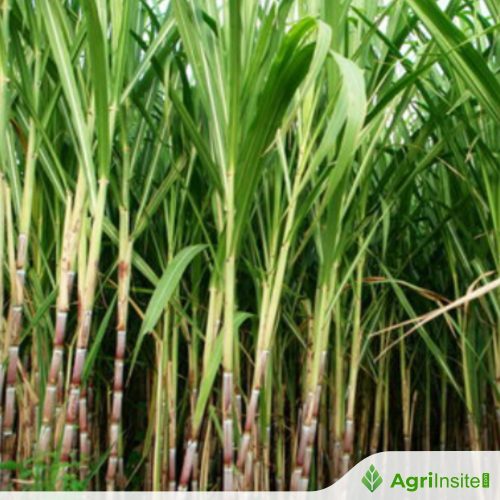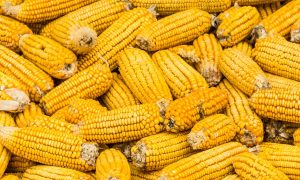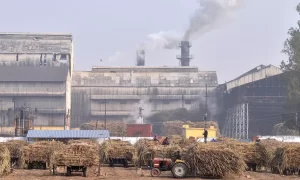Uttar Pradesh Farmer Generates Profit of About Rs 30-35 Lakh Annually through Modern Sugarcane Farming

Rakesh Sirohi, a progressive sugarcane farmer from Bulandshahr, Uttar Pradesh, adopts modern techniques like the trench method and drip irrigation, boosting yields by 35-40%. Cultivating pest-resistant varieties and practicing mixed cropping, he produces 2000 quintals per hectare. His sustainable methods, including organic fertilization, enhance soil fertility. Sirohi also produces and sells quality sugarcane seeds, earning ₹30-35 lakh annually. A role model for farmers, he demonstrates how innovation and hard work lead to success in agriculture.
Rakesh Sirohi is a progressive and skilled farmer from Bulandshahr, Uttar Pradesh, who has carved out a distinct position in the field of sugarcane farming. With a passion for agriculture and a commitment to adopting modern farming techniques, Sirohi has transformed his approach to cultivation, significantly increasing his yields and profitability. His dedication to hard work, coupled with his innovative methods, has not only made him a successful farmer but also a role model for countless others in the agricultural community.
Through his story, he continues to inspire millions of sugarcane farmers across the country to embrace new technologies, improve their practices, and achieve greater success in their own farming ventures.
Recognition and Adaption of the Modern Technique
For the last 17 years, he has been associated with the agriculture sector and has increased his yield and profits tremendously by adopting modern techniques and the latest methods in agriculture. Especially for the last 13 years, he has mainly focused on sugarcane farming, and due to this, he has been successful in achieving many important achievements in sugarcane farming.
His farm spread over about 11 hectares of land produces 2000 quintals of sugarcane per hectare, which is an example for other farmers. It is worth noting that Rakesh Sirohi secured second place in the state in the productivity award under the State Sugarcane Competition Scheme in 2020-21. Currently, Rakesh is also a member of the rate determination committee and sugarcane production competition committee of the sugarcane department.
Method of Cultivation of Sugarcane and New Varieties
Rakesh Sirohi, especially cultivates autumn sugarcane (Sugarcane Farming), the right time for sowing which is considered to be mid-September to mid-October. He has used new varieties and techniques to take sugarcane farming to new heights of success.
They cultivate new sugarcane varieties like 13235, 15023 (best for jaggery production), 18231, 16202, and 17018. A big advantage of these new varieties is that they are free from pests and diseases, which increases the yield.
Rakesh believes that a sugarcane variety should be sown only for 5-7 years, after which new varieties should be used so that there is consistency in the quality of the produce.
Soil Quality and Manure Management
According to Rakesh, before sowing sugarcane, the soil should be plowed deeply at least twice. This process breaks the hard layer below the soil and increases the flow of air and sunlight, which is beneficial for the crop. Apart from applying chemical fertilizers to his fields, Rakesh mixes Trichoderma with cow dung manure and puts it in the soil, which provides the necessary nutrients to the plants and also maintains the fertility of the soil.
Use of Organic and Natural Methods
Rakesh Sirohi cultivates 8 hectares of his farm using chemical methods, while he uses natural methods for 3 hectares. He irrigates the sugarcane crop only when the color of the soil turns white, which saves water and the crop can be saved from excess moisture.
Trench Method of Cultivation of Sugarcane
Rakesh uses the trench method in sugarcane farming. With this method, the yield of sugarcane is 35-40% more than the normal method. When sugarcane is sown with the trench method, the germination of the crop is up to 80-90%, whereas in the normal method, it is only up to 40-45%.
There are many advantages of the trench method, such as this method saves water, reducing the infestation of underground pests and termites, and there is no wastage of fertilizers. In the normal method, 28-30 quintals of seeds are required per acre, whereas in the trench method only 12-14 quintals of seeds are sufficient.
Rakesh Sirohi irrigates through the drip irrigation method, due to which the sugarcane crop gets the required amount of water, and the wastage of water is also reduced.
Mixed Cropping, Seed Production, and Innovative Techniques
Rakesh also practices mixed cropping of sugarcane, in which he grows small crops like mustard, cauliflower, brinjal, marigold, cabbage, and bitter gourd along with sugarcane. Apart from this, he is also a sugarcane seed producer and he produces sugarcane seeds by introducing new sugarcane varieties from the government.
In fact, after ordering new varieties from the government research centers in Lucknow and Shahjahanpur, they prepare them and sell them to other farmers at a price slightly higher than the government’s price, thereby increasing their income.
Due to the hard work and efficiency of farmer Rakesh Sirohi, his annual income from sugarcane farming is around 30-35 lakh rupees. 40% of his sugarcane goes to the sugar mill while 60% of the sugarcane he sells to other farmers as seed. Good yield of sugarcane crop, use of the trench method, and modern techniques have established him as a progressive farmer in Bulandshahr.
Rakesh Sirohi’s success highlights the impact of modern farming techniques and hard work. His innovative methods, like the trench system and drip irrigation, have transformed his farm and set an inspiring example for other farmers. By focusing on sustainability and diversification, he has built a profitable and efficient farming model, motivating others to embrace new practices for greater success.
To read more about Sugar Industry continue reading Agriinsite.com
Source Link : Krishi Jagran
















